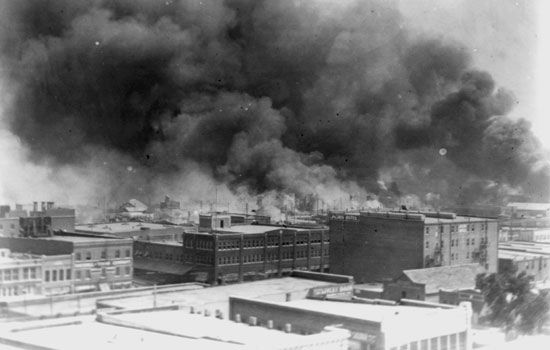 The Tulsa race massacre of 1921 was one of the most violent racial conflicts in U.S. history. The event is also called the Tulsa race riot. Mobs of angry whites killed many African Americans and destroyed Greenwood, a prosperous Black neighborhood in Tulsa, Oklahoma.
The Tulsa race massacre of 1921 was one of the most violent racial conflicts in U.S. history. The event is also called the Tulsa race riot. Mobs of angry whites killed many African Americans and destroyed Greenwood, a prosperous Black neighborhood in Tulsa, Oklahoma.
On May 30, 1921, Dick Rowland, a young African American man, was riding an elevator in a building in downtown Tulsa. The elevator was operated by Sarah Page, a white woman. Page screamed while the two were in the elevator together, and when the doors opened Rowland ran away. No one could confirm what happened, but the police arrested Rowland the next day.
On May 31 the Tulsa Tribune printed a story that claimed Rowland had tried to attack Page. The paper also informed readers that a lynching was planned for that night. Mobs of both African Americans and whites met at the courthouse where Rowland was being held. A white man and an African American man had a confrontation that resulted in the death of the white man. The white mob became upset, and the Tulsa massacre began.
Mobs of white people looted and set fire to African American businesses and homes throughout the city. Many of the whites had fought in World War I (1914–18) and were trained in the use of firearms. There were reports that they shot African Americans on sight. White officials did little to stop the violence.

 The massacre ended on June 1. It destroyed Greenwood, the successful Black neighborhood also known as the “Black Wall Street.” White rioters burned more than 1,400 homes and businesses. Nearly 10,000 people were left homeless. The official death toll was recorded at 10 whites and 26 African Americans. However, many experts believe at least 300 Black people were killed.
The massacre ended on June 1. It destroyed Greenwood, the successful Black neighborhood also known as the “Black Wall Street.” White rioters burned more than 1,400 homes and businesses. Nearly 10,000 people were left homeless. The official death toll was recorded at 10 whites and 26 African Americans. However, many experts believe at least 300 Black people were killed.
There was an official investigation shortly after the massacre, but any documents related to the event disappeared soon afterward. The incident never received widespread attention. The massacre was also left out of history books that were used to teach Oklahoma students.
In 1997 the Oklahoma legislature formed the 1921 Tulsa Race Riot Commission. Its purpose was to investigate the massacre. Members of the commission talked with survivors and gathered documents from people who had witnessed the massacre but had since died. The commission delivered its final report in 2001 and suggested that the state pay $33 million in restitution (a payment for taking something). Some of it was to go to the 121 surviving victims who had been located. However, nothing was ever done. The commission also suggested building a park to remember the massacre. The John Hope Franklin Reconciliation Park opened in 2010. Its purpose is to tell the story of the massacre and the story of African Americans’ role in building Oklahoma.
In 2019 scientists used radar to locate potential mass graves at two sites in Tulsa. Digging began in July 2020. That year Oklahoma’s education department declared that all Oklahoma schools—elementary through high schools—must teach the massacre as part of its curriculum (education plan).
In preparation for the 100th anniversary of the massacre in 2021, the 1921 Tulsa Race Massacre Centennial Commission was created. Its purpose was to highlight the rich history of the Greenwood district through various projects and programs.




